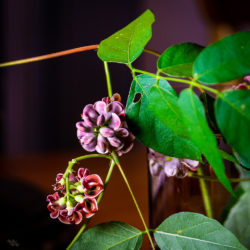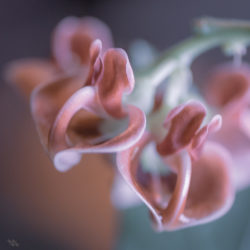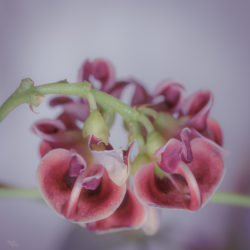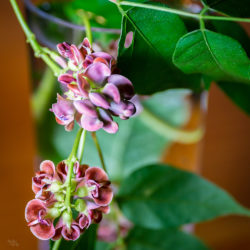Etymology
Apios is Greek for pear, referring to the shape of the tuber; americana is Latin for North or South America.
Native Habitat
Moist, shaded soil in meadows and fields, and along the shores of lakes and rivers.
Garden Uses
Attractive flowers on a vine suitable for ground cover or trellising, but when grown in optimal conditions, this plant can take over.
Overview
A climbing, perennial vine with attractive flowers and edible, starchy tubers along the length of cord-like rootstalks. Up to 20' (6m) in length.
Leaves and Stems
Leaves are green, compound, alternate, and made up of 2 to 7 discrete leaflets, with 1 leaf appearing per node along the stem. The leaf blade is entire, with no teeth or lobes. The vine is herbaceous and dies back to the ground each winter.
Flowers
Pea-like, fragrant flowers present in compact racemes arising from leaf axils. Flowers typically range in color from pink to purple or reddish-brown and are bilaterally symmetrical, with 10 stamens, 4 or 5 petals/sepals, or tepals; petals/sepals can be separate or fused into cup or tube-shape. Bloom time is July-September.
Fruit/Seed
The bean-like fruit, typically measuring 2.5-4" (60-120 mm), is dry and splits open when ripe.
Animal Associates
Flowers attract butterflies. Small nectaries on the inflorescence (flower stems) are visited by ants. Host to larva of silver-spotted skipper butterfly (Epargyreus clarus).
Propagation
Seeds, plug, root tuber or staking. Vegetative reproduction can be abundant under good conditions.
Ethnobotanical Uses
The fleshy, brown tubers were an important food for area First Nations peoples, and for early European settlers. The plant has been researched more recently for agricultural use as a food crop. Tubers can be used like a potato, in soups, stews, or fried. Cooked seeds are also edible.
Garden Location
Residential Garden (see garden map)
Sources
Lady Bird Johnson Wildflower Center
Plant Profile by Kate O’Dell





